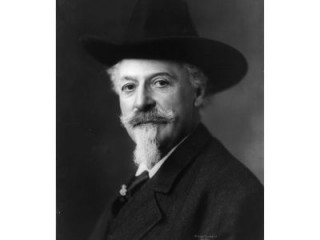
Buffalo Bill biography
Date of birth : 1846-02-26
Date of death : 1917-01-10
Birthplace : Scott County, LeClaire, Iowa
Nationality : American
Category : Famous Figures
Last modified : 2011-01-22
Credited as : Scout and publicist, Wild West hero, Great West
The controversial, half-fictitious career of William Frederick "Buffalo Bill' Cody, American scout and publicist, helped create the prototype "Wild West" hero.
William Cody, born in Scott County, lowa, and raised on a farm, served briefly in the Civil War. Hunting buffalo for construction crews of the Kansas Pacific Railroad, he was dubbed ,b>Buffalo Bill because of his proficiency. He also served as civilian scout for U.S. generals Sheridan and Carr. Though he went east to begin a stage career in 1873, he returned west in 1876 to avenge Gen. Custer's defeat. Claiming to have killed Chief Tall Bull, he later brought the Wild West indoors and toured widely with his Wild West Show. Clever publicists, like Ned Buntline, Prentiss Ingraham, and John Burke, billed him as "Prince of the Plains" and made him the hero of countless stories and novels.
Often in trouble and always in debt, Buffalo Bill toured Europe to recoup his fortunes. He became the darling of Queen Victoria's Jubilee in England and went on to France, Spain, and Italy, spreading the legend of the American West, depicting the wild yet romantic life which Europeans liked to think of as uniquely American, and paving the way for the 20th-century cowboy movie. The name Buffalo Bill was magic; in Victorian days he personified the American dream.
But triumph turned to ashes. Tired of sham hero worship, Buffalo Bill drank heavily and involved himself in many foolish liaisons. Women doted on him, but his wife wanted a divorce. Sick children sought his touch, but his only son died in his arms. Manipulated by shrewd men, he had to perform his Wild West act daily to avoid bankruptcy. Finally, disillusioned, he petitioned the Federal government for the $10 monthly Congressional Medal-holders' dole. All his dreams had become nightmares.
In 1910 Sam Goldberg released a slide series showing Buffalo Bill in action, and Harry Powers made the first moving picture of the Wild West Show, "300 thrills in 300 reels." But Bill himself was not able to utilize the new mass-media opportunities. Instead, the old man watched William S. Hart, Harry Carey, and Tom Mix fill the heroic void. When he died he was buried in Cody, Wyo.; since citizens of Denver plotted to steal the body, tons of concrete were poured over it. Thus the man whose life revolved in frantic motion had found his resting place.
Buffalo Bill epitomized a whole phase of the American western movement and the final winning of the Great West. His reputation had been contrived and half-fictitious, but to his own code and image he remained faithful.
The best contemporary accounts of Buffalo Bill are Henry L. Williams, "Buffalo Bill" (1887), and Helen Cody Wetmore, Last of the Great Scouts (1899). The only thorough and scholarly biography is Richard J. Walsh, The Making of Buffalo Bill: A Study in Heroics (1928). Dan Muller, My Life with Buffalo Bill (1948), is a convincing apologia, while James Monaghan, The Great Rascal (1952), concentrates on the feet of clay. For the Cody literature see Albert Johannsen, The House of Beadle and Adams and Its Dime and Nickel Novels: The Story of a Vanished Literature (1950).
















